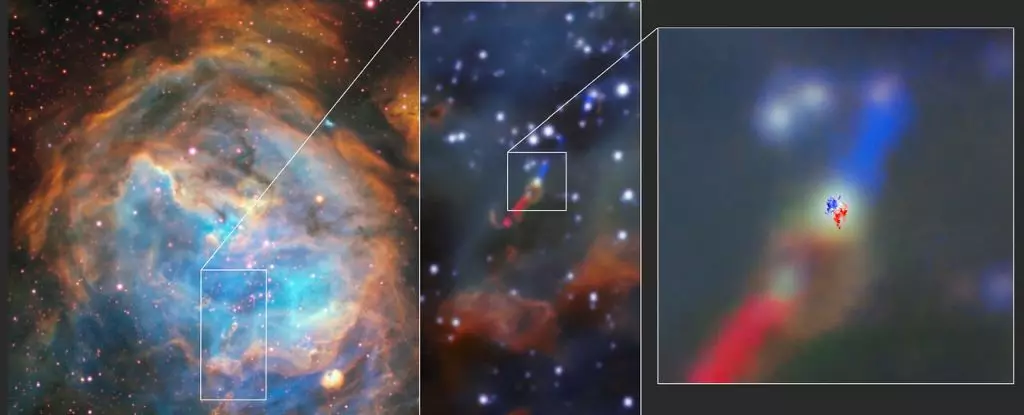Astronomers have made an incredible discovery – the first ever sighting of an extended disk of dust and gas around a star in a different galaxy. This unprecedented find was made in the Large Magellanic Cloud, a dwarf galaxy located 179,000 light-years away from the Milky Way. While the presence of a rotating disk around a star is a common occurrence in our own galaxy, the ability to observe this phenomenon in another galaxy opens up a whole new realm of possibilities for studying star formation processes. This breakthrough marks an important moment in our understanding of the universe and its diverse stellar systems.
Stars and planets are born from dense clumps in clouds of molecular gas and dust that exist in interstellar space. As these clumps become denser, they collapse under the force of gravity and start drawing in more material from the surrounding cloud. However, the material doesn’t simply fall onto the star; it arranges itself into a disk, which slowly and steadily feeds the forming star. Once the star has completed its formation, the remaining disk material clumps together to form planets, asteroids, meteors, comets, and dust. This is why the planets in our Solar System orbit the Sun in a flat plane. The discovery of an extragalactic accretion disk provides direct evidence of this fundamental process occurring in another galaxy.
The Atacama Large Millimeter/submillimeter Array (ALMA), a powerful radio telescope, has previously captured images of accretion disks within the Milky Way. These images have revealed various stages of disk development, including gaps believed to be caused by planet formation. However, observing objects in galaxies beyond our own presents challenges due to the incredible distances involved. Despite these challenges, astronomers have persevered in their quest to identify an extragalactic stellar disk.
Astronomer Anna McLeod and her team from Durham University embarked on a mission to detect an extragalactic stellar disk using the Multi Unit Spectroscopic Explorer (MUSE) instrument on the Very Large Telescope. Their efforts were rewarded when they discovered signs of rotation in a system called HH 1177. Rotating disks are indicative of star formation, as material surrounding the forming star gets whisked away along magnetic field lines to form powerful jets. These jets are often seen in the early stages of star formation.
The ALMA data confirmed the presence of a rotating disk around the young and massive HH 1177 star. This star is still in the process of feeding from the surrounding disk. However, there was a significant difference between this disk and the protostellar disks found within the Milky Way. The HH 1177 disk was visible in optical wavelengths, which suggests that the interstellar environment in the Large Magellanic Cloud contains significantly less dust. As a result, the HH 1177 star is not as heavily shrouded in dust as its counterparts in the Milky Way. This groundbreaking discovery not only provides insights into star formation in different environments but also highlights the influence of environmental factors on the formation of stars.
The discovery of the first extragalactic accretion disk opens up a host of possibilities for future research. With advancements in astronomical facilities and technologies, astronomers now have the ability to examine distant galaxies with greater detail and precision. The study of star formation processes in different environments will enhance our understanding of the complexities and universal nature of the universe. As we continue to push the boundaries of astronomical exploration, we can expect more remarkable discoveries that reshape our understanding of the cosmos.
The detection of an extragalactic accretion disk represents a significant milestone in the field of astronomy. By observing a rotating disk of dust and gas around a star in a different galaxy, astronomers have gained valuable insights into star formation processes in diverse environments. This discovery not only expands our knowledge of the universe but also serves as a reminder of the vast wonders that exist beyond our own galaxy. As technology continues to advance, we can look forward to further breakthroughs and a deeper understanding of the intricate mechanisms that shape our universe.



Leave a Reply